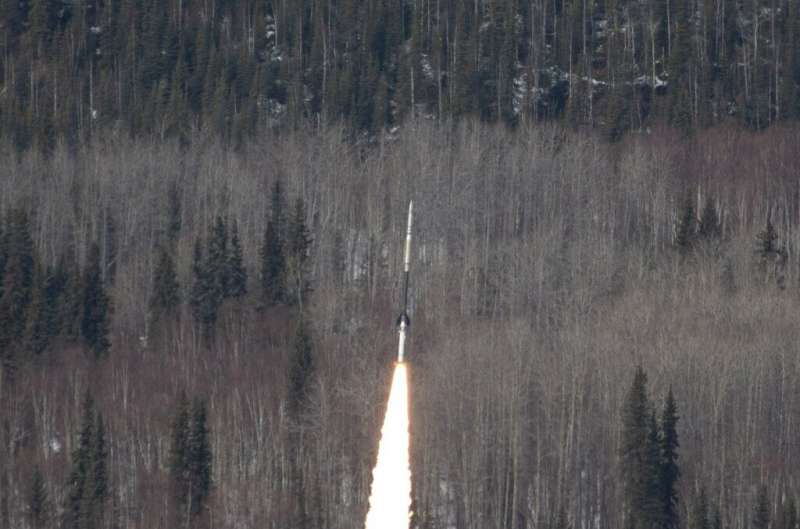
Copernical Team
Satellite technology from Surrey University aids Mauritius in illegal fishing detection
 The Mauritius Research and Innovation Council (MRIC) has teamed up with the University of Surrey to tackle illegal fishing using satellite technology. The Nereus project employs satellite imagery combined with ship location data, enhanced by artificial intelligence to identify potential illegal activities by monitoring maritime movements.
Dr. Raffaella Guida, a specialist in Satellite Remo
The Mauritius Research and Innovation Council (MRIC) has teamed up with the University of Surrey to tackle illegal fishing using satellite technology. The Nereus project employs satellite imagery combined with ship location data, enhanced by artificial intelligence to identify potential illegal activities by monitoring maritime movements.
Dr. Raffaella Guida, a specialist in Satellite Remo Evidence of long term human occupation in lava tube cave in Saudi Arabia
 A recent interdisciplinary archaeological project has uncovered significant new evidence about ancient human life in Arabia, particularly from studying caves and lava tubes, which have been less explored for archaeological evidence. This effort was spearheaded by Griffith University's Australian Research Centre for Human Evolution (ARCHE), in partnership with international teams.
The resea
A recent interdisciplinary archaeological project has uncovered significant new evidence about ancient human life in Arabia, particularly from studying caves and lava tubes, which have been less explored for archaeological evidence. This effort was spearheaded by Griffith University's Australian Research Centre for Human Evolution (ARCHE), in partnership with international teams.
The resea Vertical Future to develop crop-growing systems with UK Space Agency funding
 Vertical Future, a specialist in vertical farming technology and production based in the UK, has been awarded a new grant of GBP 1.5 million to undertake the second phase of the "Autonomous Agriculture for Space Exploration" project. The program is set to adapt Vertical Future's controlled-environment-agriculture systems for use in prototype Low Earth Orbit growing systems aboard the first comme
Vertical Future, a specialist in vertical farming technology and production based in the UK, has been awarded a new grant of GBP 1.5 million to undertake the second phase of the "Autonomous Agriculture for Space Exploration" project. The program is set to adapt Vertical Future's controlled-environment-agriculture systems for use in prototype Low Earth Orbit growing systems aboard the first comme Space Operations Command takes control of Space-Based Infrared System
 The United States Space Force's Space Systems Command (SSC) has successfully transitioned the control of the Space-Based Infrared System (SBIRS) Baseline Release (SBR 23-1) to the Space Operations Command after completing a successful trial period. This transfer to the Space Operations Center's Missile Warning Mission Area Team marks a significant milestone in the project's deployment.
"Th
The United States Space Force's Space Systems Command (SSC) has successfully transitioned the control of the Space-Based Infrared System (SBIRS) Baseline Release (SBR 23-1) to the Space Operations Command after completing a successful trial period. This transfer to the Space Operations Center's Missile Warning Mission Area Team marks a significant milestone in the project's deployment.
"Th Momentick raises funds to advance satellite-based GHG emission tracking
 Momentick, a leader in emissions intelligence, has successfully raised $6.5 million in seed funding to enhance its emission intelligence algorithm and extend its market reach. The investment round was spearheaded by Chartered Group Japan and TAU Ventures, with additional contributions from private investors.
Methane, primarily found in natural gas, is an odorless and colorless gas that can
Momentick, a leader in emissions intelligence, has successfully raised $6.5 million in seed funding to enhance its emission intelligence algorithm and extend its market reach. The investment round was spearheaded by Chartered Group Japan and TAU Ventures, with additional contributions from private investors.
Methane, primarily found in natural gas, is an odorless and colorless gas that can Desert soil microbes adapt to thrive in extreme dry conditions
 Scientists from the University of Vienna have shed light on how desert soil bacteria survive and thrive under the extreme conditions of prolonged droughts and intermittent heavy rainfall. Their findings, led by microbiologist Dagmar Woebken at the Centre for Microbiology and Environmental Systems Science (CeMESS), were recently detailed in Nature Communications.
Covering over 46% of the Ea
Scientists from the University of Vienna have shed light on how desert soil bacteria survive and thrive under the extreme conditions of prolonged droughts and intermittent heavy rainfall. Their findings, led by microbiologist Dagmar Woebken at the Centre for Microbiology and Environmental Systems Science (CeMESS), were recently detailed in Nature Communications.
Covering over 46% of the Ea Air Force Leadership Stresses Modernization and Timely Congressional Funding
 During a House committee meeting on April 17, Secretary of the Air Force Frank Kendall, along with top leaders from the Air Force and Space Force, emphasized the urgent need for Congress to provide timely and predictable funding to defend the nation effectively against modern threats.
Kendall, Air Force Chief of Staff Gen. David W. Allvin, and Chief of Space Operations Gen. Chance Saltzman
During a House committee meeting on April 17, Secretary of the Air Force Frank Kendall, along with top leaders from the Air Force and Space Force, emphasized the urgent need for Congress to provide timely and predictable funding to defend the nation effectively against modern threats.
Kendall, Air Force Chief of Staff Gen. David W. Allvin, and Chief of Space Operations Gen. Chance Saltzman MDA Space awarded extended ISS robotics contract
 MDA Space (TSX: MDA) has been granted a $250 million contract extension by the Canadian Space Agency (CSA) to continue its support for robotics operations aboard the International Space Station (ISS). The extended contract, effective from 2025 to 2030, assigns new responsibilities to MDA Space, including the role of robotics flight controllers.
"Robotics flight controllers are the pilots i
MDA Space (TSX: MDA) has been granted a $250 million contract extension by the Canadian Space Agency (CSA) to continue its support for robotics operations aboard the International Space Station (ISS). The extended contract, effective from 2025 to 2030, assigns new responsibilities to MDA Space, including the role of robotics flight controllers.
"Robotics flight controllers are the pilots i Tracing life's origins: Cambridge team explores early Earth conditions
 Researchers at the University of Cambridge have developed a model illustrating how conditions conducive to life may have arisen naturally. Their study focuses on the synthesis of essential life components like proteins, phospholipids, and nucleotides, crucially involving nitrogen-rich molecules such as nitriles and isonitriles.
Past studies have highlighted these molecules' potential in fo
Researchers at the University of Cambridge have developed a model illustrating how conditions conducive to life may have arisen naturally. Their study focuses on the synthesis of essential life components like proteins, phospholipids, and nucleotides, crucially involving nitrogen-rich molecules such as nitriles and isonitriles.
Past studies have highlighted these molecules' potential in fo Two NASA sounding rockets launch from Alaska during solar flare

Two Black Brant IX sounding rockets launched from Poker Flat Research Range in Fairbanks, Alaska, April 17, 2024, during an M-class solar flare for NASA's sounding rocket solar flare campaign.
The first rocket launched at 2:13 p.m. local Alaska time for the Focusing Optics X-ray Solar Imager (FOXSI) mission that used X-ray vision to observe the sun during the solar flare event by focusing directly on high-energy X-rays.
The second rocket launched at 2:14 p.m. for the High Resolution Coronal Imager, or Hi-C, mission designed to observe a large, active region in the sun's corona. The rockets reached altitudes up to 168 miles (271 km) and were able to successfully observe the solar flare.
Provided by NASA
































